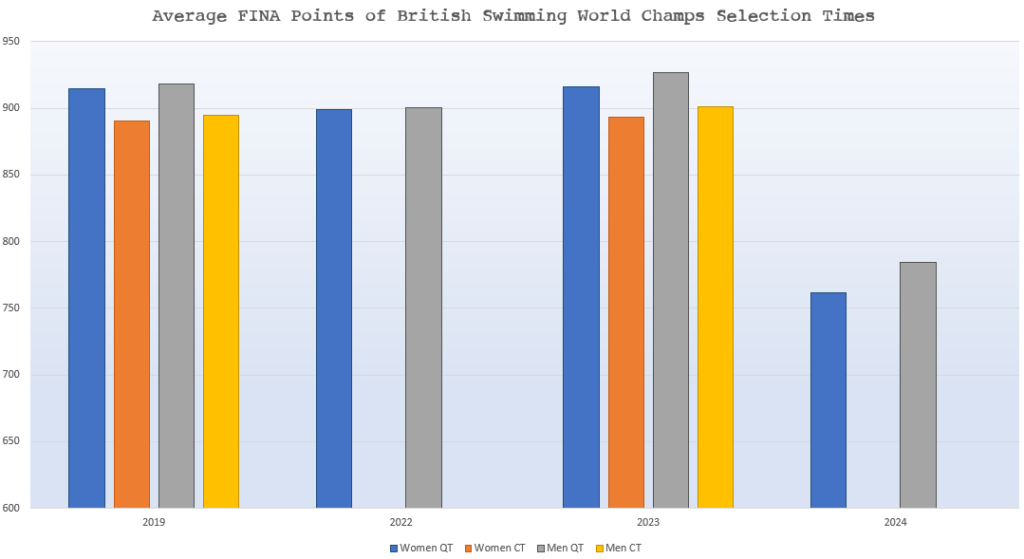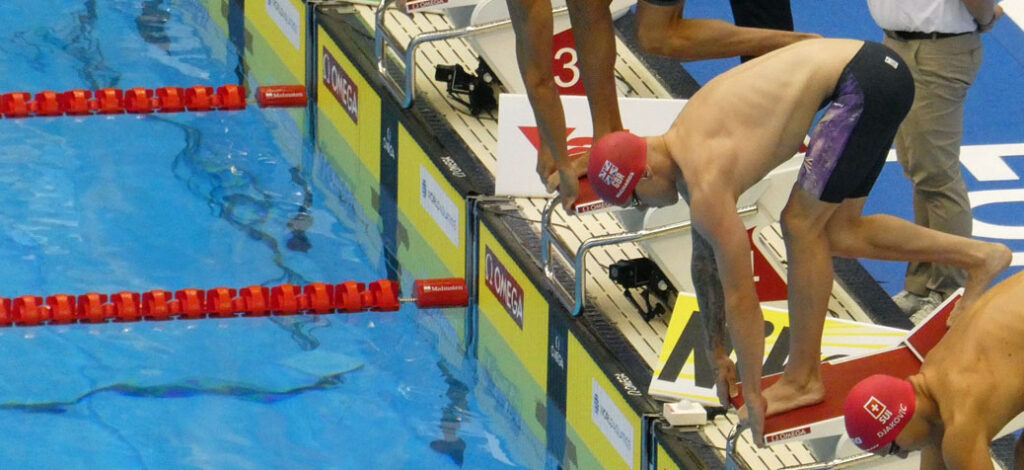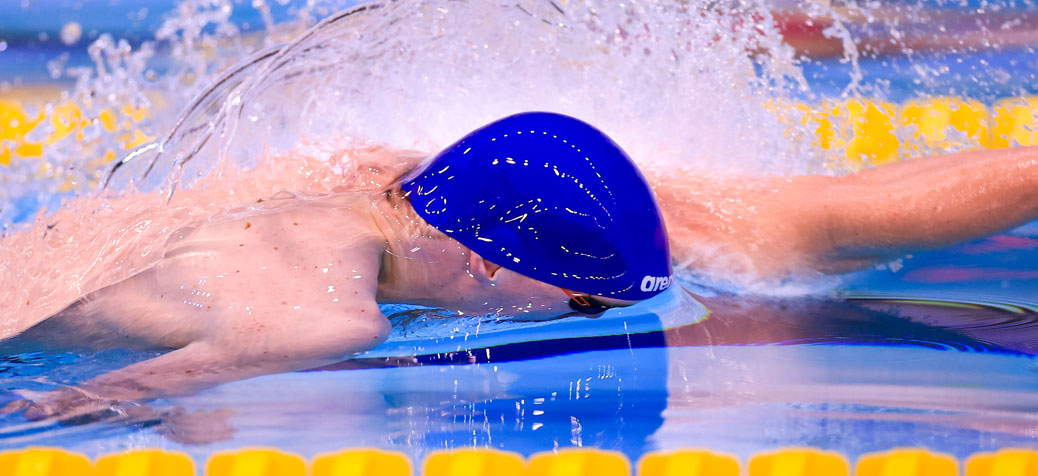A big British team will head to the European Short Championships at the start of December, but before they jump on a plane for Romania there’s the small matter of selection for the 2024 World Championships to be resolved, with a team due to be named at the end of November.
Now these championships are the ones that nobody really wanted, with Doha having been unceremoniously shunted around the calendar in the post pandemic planning chaos before alighting on a February slot in Olympic year that makes it almost a sideshow. Certainly many of Britain’s best, Adam Peaty, Duncan Scott and James Guy among them, have voiced their displeasure and intention to stay away from Qatar.
Against that backdrop then British Swimming will send a team of up to 20 swimmers, with the stated aims of securing relay qualifications for Paris and giving experience to those who are on a “trajectory for podium performance” in either Paris or LA four years later. At the same time they have made it clear that swimming individual events at the meet is entirely optional. The policy digresses from the normal format, in keeping with the meet itself, but here’s how it works and some of the questions it raises.
The Policy
Relays will be picked from performances at the world championships in Fukuoka with priority given to teams who have not secured qualification already. But more on that aspect in a moment.
Once the relevant relay squads are picked the team can be filled up to the maximum of 20 for individual events. The policy says that performances in Olympic events between 1st May 2023 and 30th August 2023 (a period that notably locks out this year’s British Championships) will be ranked against the list of consideration times, using the percentage inside the time as the determining factor.
Those times are not tough – indeed they are the slowest selection times that Bill Furniss and Chris Spice have put out there with the average FINA points being almost 150 less than has been typical (see the graph below to illustrate). This wide net is presumably designed to give maximum flexibility on selection against the likelihood that many of Britain’s best will simply opt to skip the meet given half a chance to do so.

Who does this put in the frame then? We’ve crunched the numbers and come up with the top 45 swimmers who meet the selection criteria, in the list you can download below. This suggests that the likes of Honey Osrin, Amelie Blocksidge, Leah Schlossan and Alex Cohoon could be well in the frame, but it’s hard to draw any meaningful conclusions without knowing what the relay approach will be, who decides to opt out and hence how many spots will be left open.
The Relay Conundrum
This is really what the meet is all about for Britain, with Doha forming the second part of Olympic qualification for the Paris Games. The world medallists plus the next top 13 teams across combined heats and finals from Doha and Fukuoka will receive invitations to Paris, so there is plenty still to swim for.
Only the men’s 4 x 200 freestyle relay is assured of a lane at the Olympics, having won the gold medal in Fukuoka and thereby meeting the top 3 criterion. As such, the other six relay teams remain in limbo until the Doha championships are concluded. There’s no need for them to compete to gain a spot, as times from Fukuoka will still be in play, but that equally means the one relay that must compete is the men’s 4x100m freestyle team who were disqualified in Fukuoka and hence are not currently ranked.
On a notional basis that team would have been right up there, and with the 16th ranked nation, Sweden at 3:16.07, it seems highly likely that even a semi-rested quartet drawn from Britain’s freestyle group could get GB into the qualifying places.
How the Men’s 4×100 free top 8 currently ranks
- Australia – 03:10.16
- Great Britain – 03:10.47 Unofficial
- Italy – 03:10.49
- USA – 03:10.81
- China – 03:11.38
- Canada – 03:12.05
- Brazil – 03:12.71
- Israel – 03:14.03 heat
- Spain – 03:13.77 heat
We speculated on the world championships podcast that this might entail a “blink and you’ll miss it” trip to the middle east for this team, something that Matt Richards almost endorsed when speaking to Propulsion Swimming in the aftermath of Fukuoka, where he confirmed he wanted to go and make sure the team would swim at the Olympics.

“Personally my my opinion on it is that I’d like to go, I’d like to be there and be part of that team to make sure” he said. “There’s been a few options bandied around so far but I want to make sure we’re there and we get the spot.
“And if that means I need to go to Doha, even if that means we fly in the night before and fly out the evening after the race so be it . I’m happy to turn up, get it done and get out of there.”
So it seems certain that this team will swim, and that it will be close to full strength, but the rest are not so straightforward.
How do GB’s other relays rank?
Here is how GBs relay teams currently rank in the qualification standings based on their performances in Fukuoka, with the women’s medley relay the lowest ranked team in 9th and all the others 5th or higher.
For those ranked top 5 or better, it seems incredibly unlikely that they would be overtaken by all of the teams currently below them in the top 16 plus one or two more and hence miss out on Paris. The women’s medley team might have a bit more jeopardy but even then it would require the likes of Belgium and Hong Kong to improve by 6 seconds from 2023 Worlds to knock them out. It may be then that there is no need to send teams at all and bank on what has already been secured.
We do need to remember that his policy was published before Fukuoka so some of its provisions were made without the benefit of results there, but we have seen that Furniss and Spice cab be quite risk averse and may therefore decide to twist rather than stick. That of course leads to the inevitable follow up question of whether any of GB’s teams could be expected to swim faster at a February world championships with Olympic trials looming than they did in the heat of their targeted meet of the year in 2023. That seems unlikely and there may be more to lose than to gain.
It’s quite likely then that we’ll see a team which features the men’s 4×1 squad, a few other senior swimmers who choose to replace their typical early season hit outs at the likes of the Flanders Open or the Euro Meet in Luxembourg with a trip to the World Championships, and then a team topped up with some up and coming swimmers looking for experience. Don’t be surprised though if the team is firmly under the 20 swimmer limit when it is named on or around the 30th November.
Banner image: British Swimming/Georgie Kerr

